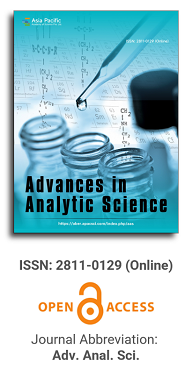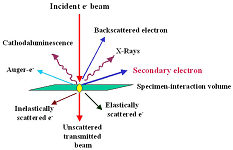
Asia Pacific Academy of Science Pte. Ltd. (APACSCI) specializes in international journal publishing. APACSCI adopts the open access publishing model and provides an important communication bridge for academic groups whose interest fields include engineering, technology, medicine, computer, mathematics, agriculture and forestry, and environment.

Recent developments in analytical methods for inorganic elements in foods
Vol 1, Issue 1, 2020
Download PDF
Abstract
Inorganic elements play a crucial role in both nutrition and health safety. Analyzing these elements in food helps assess its nutritional value, prevent the consumption of toxic or harmful substances, and understand the extent of contamination to identify and control pollution sources. Additionally, it aids in the production and development of fortified foods, enhances food processing technologies, and improves overall food quality. Therefore, monitoring and detecting inorganic elements during food production is essential. This paper reviews the main methods and characteristics of inorganic element analysis in food, both domestically and internationally, highlighting trends in analytical techniques, including traditional chemical and physical methods, as well as recent advances in nanotechnology and biotechnology. It also summarizes the practical applications of these analytical methods in recent years.
Keywords
References
- Zhao JW, Sun YH. Modern food detection technique. China Light Industry Press; 2008.
- An JB, Zhang RJ. Analysis of poisonous elements in food. Foreign Med Sci. 2008; 29: 133-137.
- Wan Y. Determination and analysis of elemental speciation in foods. Mod Measure Lab Manage. 2013; (3): 20-21.
- Yi JP, Ying Y, Li X. Modern test method for trace elements in foods. J Henan Sci Technol Univ (Nat Sci Ed). 2004; 25: 89-92.
- Yang YG. A method for determination of heavy metals in foods. Sci Technol Inf Dev Econ. 2009; 18: 217-218.
- Wu FQ. DBM-MSA photometric determination of lead in preserved eggs. Spectrosc Lab. 2004; 21: 99-101.
- Shi BH, Kong SX, Kang YH. Improvement of dithizone spectrophotometric method for determination of trace lead in water. Chin J Prev Med. 2003; 37: 273-275.
- Kai QY. Determination of trace lead in popcorn by dithizone spectrophotometry. Liaoning Chem Ind. 2012; 41: 21-25.
- Dong SG. Determination of trace zinc in tea by cloud point extraction spectrophotometry. Spectrosc Lab. 2011; 3125-3128.
- Lv HJ. Determination of zinc in water by water phase dithizone spectrophotometry. Guide o Sci Technol. 2011; 30: 251-251.
- Wang RB. Rapid determination of trace lead in Chinese cabbage by dithizone colorimetric colorimetric method. Northwest Agric J. 2006; 15: 109-111.
- Wang L, Zhang R. Application and discussion of polarographic analysis in food hygiene monitoring field. Chin J Food Hyg. 2001; 13: 42-44.
- Wang QR. Determination of total selenium in food by polarography. J Qiqihar Med Coll. 2007; 28: 1081-1082.
- Xi X, Yang W, Ming L. Determination of cadmium in bean paste by linear sweep stripping voltammetry. China Condim. 2012; 37(10): 77-79.
- Wang ZD, Sun RD. Determination of lead in vegetables by differential pulse anodic stripping voltammetry with modified mercury film electrode. Environ Monit Manage Technol. 2013; 25(1): 30-32.
- Sa RGW, Ma K, Hu WZ, et al. Determination of trace elements in capsicum and chili foods by atomic absorption spectrometry. Sci Technol Food Ind. 2013; 33: 68-70.
- Tai CJ, Xing W. Determination of aluminum in flour food by graphite furnace atomic absorption spectrometry. Spectrosc Lab. 2008; 25: 428-430.
- Qin JH, Chen J, Xiang GQ, et al. Determination of trace copper in foods and beverages by cloud point extraction flame atomic absorption spectrometry. Chem Res. 2010; 21: 72-75.
- Zhang HK, Wang ZR, Fang HD, et al. Determination of lead in preserved egg by flow injection and flame atomic absorption spectrometry. Food Sci. 2012; 33: 233-236.
- Liu HH, Zhao R, Wei C, et al. Study on high performance liquid chromatography coupled witH2O2n-line digestion hydride generation atomic absorption spectrometry. Anal Chem. 2005; 33: 1522-1526.
- García-Salgado S, Quijano MA, Bonilla MM. Arsenic speciation in edible alga samples by microwave-assisted extraction and high performance liquid chromatography coupled to atomic fluorescence spectrometry. Anal Chim Acta. 2012; 714: 38-46.
- Liang QZ, Huang TY, Li YZ. Determination of tin in canned foods by microwave digestion and hydride generation atomic fluorescence spectrometry. Guangdong Trace Element Sci. 2012; 19: 50-54.
- Zhai MX, Li ZQ, Cao RM. Simultaneous determination of arsenic and mercury in food by microwave digestion atomic fluorescence spectrometry with trace acid. Chin J Food Hyg. 2006; 18: 538-539.
- Zhang L, Han GC. Determination of lead in food additives by flow injection hydride generation atomic fluorescence spectrometry. Food Ferment Ind. 2005; 31: 97-99.
- Mao H, Liu LP, Zhang NN, et al. Study and comparison of methods for determination of lead, cadmium and copper in foods by ICP-MS and AAS. Chin J Health Lab. 2007; 1954-1955.
- Chen WZ, Chen YS, Lai HQ. Determination of heavy metals in food by microwave digestion ICP-AES. Food Res Dev. 2008; 29: 98-100.
- Moreda PA, Fisher A, Hill SJ. The classification of tea according to region of origin using pattern recognition techniques and trace metal data. J Food Composit Anal. 2003; 16: 195-211.
- McKenzie JS, Jurado JM, Pablos FD. Characterization of tea leaves according to their total mineral content by means of probabilistic neural networks. Food Chem. 2010; 123: 859-864.
- Liu HS, Shao HX. Inductively coupled plasma mass spectrometry and its applications. Chemical Industry Press; 2005.
- Huerta VD, Sanchez ML, Alfredo SM. Qualitative and quantitative speciation analysis of water soluble selenium in three edible wild mushrooms species by liquid chromatography using post-column isotope dilution ICP-MS. Anal Chim Acta. 2005; 538: 99-105.
- Tang SY, Liu Y, Wang J, et al. Study on the origin characteristics of mineral elements in tea in Chongqing area. Food Sci. 2013; 34: 227-230.
- Li G, Gao MY, Zhu K. Determination of trace elements in plant samples by inductively coupled plasma mass spectrometry with microwave digestion. Rock Mineral Test. 2010; 29: 17-22.
- Wang YL, Wang X, Zhang XH, et al. Determination of 15 rare earth elements in drinking water by inductively coupled plasma mass spectrometry. Environ Monit Manage Technol. 2013; 25: 37-39.
- Wang DQ, Jiang ZM, Tian R, et al. Determination of calcium in milk powder by energy dispersive X ray fluorescence spectrometry. Food Sci. 2013; 34: 254-257.
- Zhang HM, Wang WJ, Li XY. Determination of trace elements in spirulina and donkey hide gelatin by X ray fluorescence spectrometry. Spectrosc Lab. 2008; 25: 150-151.
- Chang G, Jiang ZC, Peng TY, et al. The preparation of nano-alumina with high specific surface area and its study on the adsorption behavior of transition metal ions were prepared by sol-gel method. J Chem. 2003; 61: 100-103.
- Liu H, Zhou ZZ. Determination of manganese in food by graphite furnace atomic absorption spectrometry with enrichment and separation of nano TiO2. Chem Ind Time. 2008; 22: 18-20.
- Wang H, Wang Y, Jin J, et al. Gold nanoparticle-based colorimetric and “turn-on” fluorescent probe for mercury(ii) ions in aqueous solution. Anal Chem. 2008; 80: 9021-9028.
- Takafuji M, Ide S, Ihara H, et al. Preparation of poly(1-vinylimidazole)-grafted magnetic nanoparticles and their application for removal of metal ions. Chem Mater. 2004; 16: 1977-1983.
- Yoza B, Matsumoto M, Matsunaga T. DNA extraction using modified bacterial magnetic particles in the presence of amino silane compound. J Biotechnol. 2002; 94: 217-224.
- Böhmer V, Dozol J, Grüttner C, et al. Separation of lanthanides and actinides using magnetic silica particles bearing covalently attached tetra-CMPO-calix[4]arenes. Organic Biomol Chem. 2004; 2: 2327-2334.
- Xu Y, Zhou Y, Ma W, et al. Functionalized magnetic core-shell Fe3O4@SiO2nanoparticles for sensitive detection and removal of Hg2+. J Nanopart Res. 2013; 15: 1716-1722.
- Xu Y, Zhou Y, Ma W, et al. Highly sensitive and selective OFF-ON fluorescent sensor based on functionalized Fe3O4@SiO2 nanoparticles for detection of Zn2+ in acetonitrile media. Appl Surface Sci. 2013; 276: 705-710.
- Xu X, Zhou Y, Ma W, et al. A fluorescent sensor for zinc detection and removal based on core-shell functionalized Fe3O4@SiO2 nanoparticles. J Nanomater. 2013; (6): 2527-2531.
- Wu WJ, Wu ZZ, Wu WH. Comparison of Pu’er tea polysaccharide tea polyphenols and lipid lowering function. Fujian Tea. 2007; (3): 42-43.
- Reardan DT, Meares CF, Goodwin DA, et al. Antibodies against metal chelates. Nature. 1985; 316(6025): 265- 268.
- Khosraviani M, Pavlov AR, Flowers GC, et al. Detection of heavy metals by immunoassay: optimization and validation of a rapid, portable assay for ionic cadmium. Environ Sci Technol. 1998; 32: 137-142.
- Duan L, Ye X, Jiang L. Colloidal gold immunochromatographic assay and its potential application in animal quarantine. Livestock Poult Ind. 2004; 1: 59-60.
- Yan H, Shen HF. Application and prospect of colloidal gold immunochromatographic assay. Prog Microbiol Immunol. 2005; 33: 86-88.
- Xiang JJ, Chen YQ, Tang Y, et al. Rapid determination of cadmium in water samples by colloidal gold immunochromatographic assay. Chin J Biol. 2010; 23: 529-532.
- Liu JP, Li J, Ge X. Determination of cadmium, tin and lead in food by glucose oxidase inhibition method. J Beijing Univ Agric. 2007; 2007: 59-62.
- Li N, Jiang ZT, Li R. Kinetic spectrophotometric determination of mercury with horseradish peroxidase. Spectrosc Lab. 2006; 23: 1311-1313.
- Kou DM. Enzyme membrane biosensor for rapid detection of heavy metal ions and its application. Southwestern University; 2011.
Supporting Agencies
Copyright (c) 2020 Hongben Yang, Fan Yang, Zengbin Hu, Xiang Bai

This work is licensed under a Creative Commons Attribution 4.0 International License.

This site is licensed under a Creative Commons Attribution 4.0 International License (CC BY 4.0).
1.jpg)
Prof. Sivanesan Subramanian
Anna University, India





.jpg)
